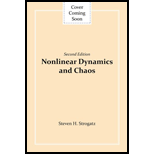
Interpretation:
To show explicitly that bead’s kinetic and potential energy is not conserved when it is in constant motion. Find the physical interpretation of the conserved quantity.
Concept Introduction:
Express the total energy by considering rotational and translation motion of the hoop and bead.
Find the derivative of the energy to determine the energy is conserved or not.
Answer to Problem 17E
Solution:
It is shown that the bead’s kinetic and potential energy is not conserved when it is in motion. The physical interpretation of the conserved quantity is stated.
Explanation of Solution
Given information:
The system is with bead and hoop in motion.
The total energy is expressed as
Here,
This energy
For the bead’s motion, the energy equation is given as,
Here
The conserved energy when
By dividing both sides by
The energy equation for the bead system is as,
By substituting
Hence the conserved energy when
We have to show that the bead’s kinetic energy and potential energy is not conserved. Consider the system with hoop and bead.
When the hoop has zero potential energy, if the bead is at the vertical height of the hoop then e
Here are the two kinetic energies, translational and rotational energy.
Considering the kinetic energy due to the rotation of bead around the vertical rotational axis of the hoop. This rotational kinetic energy depends on the horizontal distance from the rotational axis and the rotation rate of the hoop
It is given by,
Total kinetic energy is given by,
Hence total energy is given as,
To determine the conserved energy we will take the derivative with respect to
By substituting
Since
As the hoop transfer the energy to the bead when it goes away from the bottom. This hoop has a constant rotation rate and it is denoted by
For a system, the conserved quantity is the Hamiltonian denoted by
It is shown that the bead’s kinetic and potential energy is not conserved when it is in constant motion. The physical interpretation of the conserved quantity is stated.
Want to see more full solutions like this?
Chapter 6 Solutions
Nonlinear Dynamics and Chaos
- Algebra & Trigonometry with Analytic GeometryAlgebraISBN:9781133382119Author:SwokowskiPublisher:Cengage
 Trigonometry (MindTap Course List)TrigonometryISBN:9781337278461Author:Ron LarsonPublisher:Cengage Learning
Trigonometry (MindTap Course List)TrigonometryISBN:9781337278461Author:Ron LarsonPublisher:Cengage Learning Functions and Change: A Modeling Approach to Coll...AlgebraISBN:9781337111348Author:Bruce Crauder, Benny Evans, Alan NoellPublisher:Cengage Learning
Functions and Change: A Modeling Approach to Coll...AlgebraISBN:9781337111348Author:Bruce Crauder, Benny Evans, Alan NoellPublisher:Cengage Learning


